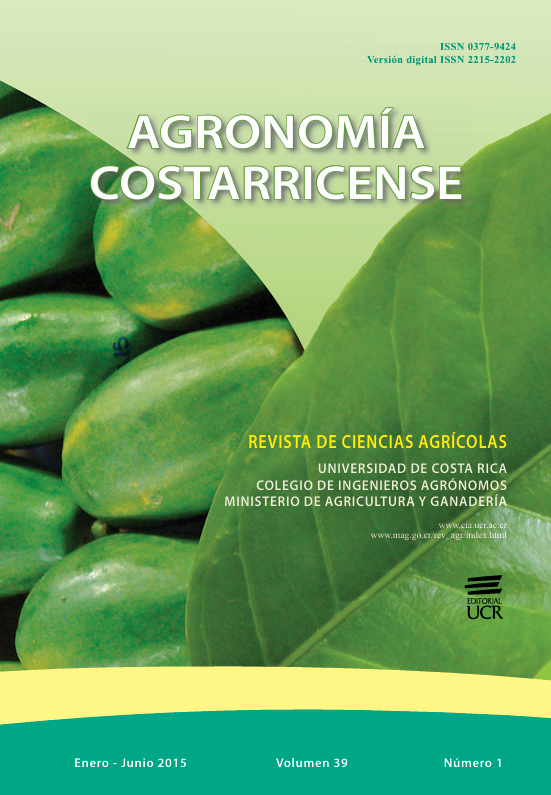Resumen
Se evaluó el efecto de 3 niveles de humedad en el sustrato sobre el crecimiento y producción comercial de 2 híbridos de chile dulce establecidos bajo condiciones de invernadero. El ensayo se efectuó en el invernadero multicapilla de la Estación Experimental Fabio Baudrit Moreno en La Garita, Alajuela, y los materiales evaluados fueron los híbridos Villaplants Americano (de fruta cuadrada tipo blocky color amarillo) y FBM-9 (de fruta cónica color rojo), ambos genotipos de origen nacional. El primer tratamiento consistió en el suministro de agua la planta a capacidad de campo (CC) mientras que al segundo y tercer tratamiento se le restó a la planta el 15 y el 30%, respectivamente, de ese aporte original de agua. Se demostró que no hay un efecto en la cantidad de agua suministrada sobre el crecimiento de la planta aunque sí se observó que plantas sometidas a estrés hídrico comenzaron primero su fase de floración y fructificación. Para ambos híbridos se obtuvo una disminución en la cantidad de frutos de primera y segunda, y un aumento en fruta de rechazo, conforme se limitó el riego. La pudrición apical fue la principal causa de rechazo producto de la falta de agua, asociado con la poca disponibilidad de calcio. El rendimiento comercial más alto se obtuvo con el híbrido Villaplants Americano (31,8 ton.ha-1), aunque sin deferencia estadística entre sustratos a CC y CC–15%, pese a que sí disminuyó la calidad de la fruta con ese último tratamiento. Lo mismo se observó para el híbrido FBM-9. Con el tratamiento CC–30% se afectó tanto el rendimiento comercial como la calidad de la fruta, en ambos híbridos.Citas
ALLEN R., PEREIRA L., RAES D., SMITH M. 1998. Crop evapotranspiration: Guidelines for computing crop water requirements. FAO: Irrigation and drainage Nº. 56. Italia, sp.
ANDRIOLO J.L. 1999. Fisiologia das culturas protegidas. Editora UFSM, Brasil.142 p. CALVO L.R. 2005. Métodos de riego: un enfoque práctico para el diseño. Asociación Costarricense de la Ciencia del Suelo, Costa Rica. 168 p.
CHARTZOULAKIS K., DROSOS N. 1997. Water requirements of greenhouse grown pepper under drip irrigation. Acta Horticulturae 449(1):175-180.
GLIESSMANN S.R. 2002. Agroecología: procesos ecológicos en agricultura sostenible. CATIE, Costa Rica. 359 p.
JOVICICH E., CANTLIFFE D.J., STOFELLA P.J., HAMAN D.Z. 2007. Bell pepper fruit yield and quality as influenced by solar radiation-based irrigation and container media in a passively ventilated greenhouse. Hort Science 42(3):642-652.
METIN SEZEN S., YAZAR A., EKER S. 2006. Effect of drip irrigation regimes on yield and quality of field grown bell pepper. Agriculture Water Management 81:115-131.
NAPIER D.R., COMBRINK N.J. 2006. Aspects of calcium nutrition to limit plant physiological disorders. Acta Horticulturae 702:107-116.
NICOLA S., TIBALDI G., FONTANA E. 2009. Tomato production systems and their application to the tropics. Acta Horticulturae 821:27-33.
OJEDA W. 2004. Programación del riego bajo condiciones de invernadero. III Curso Internacional de Invernaderos. Tomo II. Universidad Autónoma de Chapingo, México. 71 p.
PEET M.M., WILLITS D.H. 1995. Role of excess water in tomato fruit cracking. HortScience 30(1):65-68.
PEIL R.M., GALVEZ J.L. 2005. Reparto de materia seca como factor determinante de la producción de las hortalizas de fruto cultivadas en invernadero. R. Bras. Agrociência 11(1):5-11.
SNYDER R.G. 2006. Guía del cultivo del tomate en invernaderos. Servicio de Extensión Universidad Estatal de Mississippi, USA. Publicación Nº 2419. 24 p.
TAKANE R.J., YANAGISAWA S.S., De ASSIS E. 2013. Técnicas em substratos para a floricultura. Fortaleza: Expressão Gráfica e Editora, Brasil. 147 p.
TAYLOR M.D., LOCASCIO S.J., ALLIGOOD M.R. 2004. Blossom-end rot incidence of tomato as affected by irrigation quantity, calcium source, and reduced potassium. HortScience 39(5):1110-1115.
TESI R. 2000. Medios de protección para la hortoflorofruticultura y el viverismo. Ediciones Mundi Prensa, España. 289 p.
VILLALOBOS E. 2001. Fisiología de la producción de los cultivos tropicales. Fascículo I. Editorial Universidad de Costa Rica, Costa Rica. 228 p.
WALLER P. 2004. Microirrigación en invernaderos y sistemas de fertirrigación. III Curso Internacional de Invernaderos. Tomo II. Universidad Autónoma de Chapingo, México. 17 p.


